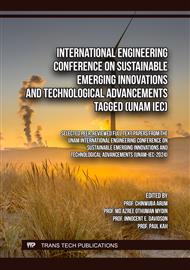[1]
Alghofaili, Y., Albattah, A., & Rassam, M. A. (2020). A financial fraud detection model based on LSTM deep learning technique. Journal of Applied Security Research, 15(4), 498-516
DOI: 10.1080/19361610.2020.1815491
Google Scholar
[2]
Al-Hashedi, K. G., & Magalingam, P. (2021, May). Financial fraud detection applying data mining techniques: A comprehensive review from 2009 to 2019. Computer Science Review, 40, 100402
DOI: 10.1016/j.cosrev.2021.100402
Google Scholar
[3]
Ali, J., Khan, R., Ahmad, N., & Maqsood, I. (2012). Random Forests and Decision Trees. International Journal of Computer Science Issues (IJCSI), 9(5), 272. Retrieved April 27, 2024, from www.IJCSI.org
Google Scholar
[4]
Ashtiani, M. N., & Raahemi, B. (2021). Intelligent Fraud Detection in Financial Statements Using Machine Learning and Data Mining: A Systematic Literature Review. IEEE Access, 10, 72504-72525
DOI: 10.1109/ACCESS.2021.3096799
Google Scholar
[5]
Bakumenko, A., & Elragal, A. (2022). Detecting Anomalies in Financial Data Using Machine Learning Algorithms. Systems, 10(5), 30
DOI: 10.3390/systems10050130
Google Scholar
[6]
Bhavitha, B. K., Rodrigues, A. P., & Chiplunkar, N. N. (2017). Comparative study of machine learning techniques in sentimental analysis. In 2017 International conference on inventive communication and computational technologies (ICICCT) (pp.216-221). Coimbatore, India: Institute of Electrical and Electronics Engineers (IEEE)
DOI: 10.1109/ICICCT.2017.7975191
Google Scholar
[7]
Breiman, L. (2001, October). Random Forests. Machine learning, 45, 5-32
DOI: 10.1023/A:1010933404324
Google Scholar
[8]
Chatfield, C. (2018). Introduction to Multivariate Analysis (1 ed.). New York
DOI: 10.1201/9780203749999
Google Scholar
[9]
Chen, S., Goo, J. Y.-J., & Shen, Z.-D. (2014). A hybrid approach of stepwise regression, logistic regression, support vector machine, and decision tree for forecasting fraudulent financial statements. (S. Ding, Ed.) The Scientific World Journal, 2014
DOI: 10.1155/2014/968712
Google Scholar
[10]
Craja, P., Kim, A., & Lessmann, S. (2020). Deep learning for detecting financial statement fraud. Decision Support Systems, 139, 113421
DOI: 10.1016/j.dss.2020.113421
Google Scholar
[11]
Deng, Q. (2010). Detection of fraudulent financial statements based on Naïve Bayes classifier. 2010 5th International Conference on Computer Science & Education (pp.1032-1035). Hefei, China: IEEE
DOI: 10.1109/ICCSE.2010.5593407
Google Scholar
[12]
Deng, Q., & Mei, G. (2009). Combining self-organizing map and K-means clustering for detecting fraudulent financial statements. 2009 IEEE international conference on granular computing (pp.126-131). Nanchang, China: IEEE
DOI: 10.1109/GRC.2009.5255148
Google Scholar
[13]
Devi, V. J., & Kavitha, K. S. (2017). Fraud Detection in Credit Card Transactions by using Classification Algorithms. 2017 International Conference on Current Trends in Computer, Electrical, Electronics and Communication (CTCEEC) (pp.125-131). Mysore, India: IEEE
DOI: 10.1109/CTCEEC.2017.8455091
Google Scholar
[14]
FTC. (2024, February 09). As Nationwide Fraud Losses Top $10 Billion in 2023, FTC Steps Up Efforts to Protect the Public. USA. Retrieved from https://www.ftc.gov/
Google Scholar
[15]
Gupta, S., & Mehta, S. (2021). Data Mining-based Financial Statement Fraud Detection: Systematic Literature Review and Meta-analysis to Estimate Data Sample Mapping of Fraudulent Companies Against Non-fraudulent Companies. Global Business Review
DOI: 10.1177/0972150920984857
Google Scholar
[16]
Hamal, S., & Senvar, O. (2021). Comparing performances and effectiveness of machine learning classifiers in detecting financial accounting fraud for Turkish SMEs. International Journal of Computational Intelligence Systems, 14(1), 769-782. Retrieved from https://www.atlantis-press.com/journals/ijcis/issue/498
DOI: 10.2991/ijcis.d.210203.007
Google Scholar
[17]
HaratiNik, M. R., Akrami, M., Khadivi, S., & Shajari, M. (2012). A hybrid model for credit card fraud detection. 6th international symposium on telecommunications (IST) (pp.1088-1093). Tehran, Iran: IEEE
DOI: 10.1109/ISTEL.2012.6483148
Google Scholar
[18]
Huang, Z., Zheng, H., Li, C., & Che, C. (2024, March). Application of Machine Learning-Based K-Means Clustering for Financial Fraud Detection. Academic Journal of Science and Technology, 10(1), 33-39
DOI: 10.54097/74414c90
Google Scholar
[19]
Kirlidog, M., & Asuk, C. (2012, October 2024). A Fraud Detection Approach with Data Mining in Health Insurance. Procedia - Social and Behavioral Sciences, 62, 989-994
DOI: 10.1016/j.sbspro.2012.09.168
Google Scholar
[20]
Kroll. (2024, July 20). Publications. Retrieved from https://www.kroll.com/
Google Scholar
[21]
MDPI Books. (2023). Special Issue Reprint: Applied Machine Learning. (G. Dudek, Ed.) Applied Sciences
DOI: 10.3390/books978-3-0365-7907-8
Google Scholar
[22]
Paula, E. L., Ladeira, M., Carvalho, R. N., & Marzagão, T. (2016). Deep Learning Anomaly Detection as Support Fraud Investigation in Brazilian Exports and Anti-Money Laundering. In 2016 15th ieee international conference on machine learning and applications (icmla) (pp.954-960). Institute of Electrical and Electronics Engineers (IEEE)
DOI: 10.1109/ICMLA.2016.0172
Google Scholar
[23]
Rajak, I., & Mathai, J. K. (2015, September). Intelligent fraudulent detection system based SVM and optimized by danger theory. International Conference on Computer, Communication and Control (IC4), 1-4
DOI: 10.1109/IC4.2015.7375705
Google Scholar
[24]
Sanad, Z., & Al-Sartawi , A. (2021). Financial statements fraud and data mining: a review. In European, Asian, Middle Eastern, North African Conference on Management & Information Systems. 239, pp.407-414. Springer International Publishing. Retrieved October 4, 2023, from https://link.springer.com/chapter/
DOI: 10.1007/978-3-030-77246-8_38
Google Scholar
[25]
Sheshasayee, A., & Thomas, S. S. (2017, February). Implementation of data mining techniques in upcoding fraud detection in the monetary domains. 2017 international conference on innovative mechanisms for industry applications (ICIMIA, 730-734
DOI: 10.1109/ICIMIA.2017.7975561
Google Scholar
[26]
Singh, A., & Jain, A. (2020, February 02). An Empirical Study of AML Approach for Credit Card Fraud Detection—Financial Transactions. International Journal of Computers Communications & Control, 14(6), 670-690
DOI: 10.15837/ijccc.2019.6.3498
Google Scholar
[27]
Sudjian, A., Yuan, M., Kern, D., Nair, S., Zhang, A., & Cela-Díaz, F. (2010, February). Statistical Methods for Fighting Financial Crimes. Technometrics, 52(1), 5-19. Retrieved May 07, 2024, from https://www.jstor.org/stable/40586676
DOI: 10.1198/tech.2010.07032
Google Scholar
[28]
Sulaiman, R. B., Schetinin, V., & Sant , P. (2022, May 05). Review of Machine Learning Approach on Credit Card Fraud Detection. Human-Centric Intelligent Systems, 2(1), 55-68
DOI: 10.1007/s44230-022-00004-0
Google Scholar
[29]
Wang, X., Wu, H., & Yi, Z. (2018). Research on Bank Anti-Fraud Model Based on K-Means and Hidden Markov Model. 2018 IEEE 3rd International Conference on Image, Vision and Computing (ICIVC) (pp.780-784). Chongqing, China: IEEE. Retrieved May 21, 2024, from https://ieeexplore.ieee.org/document/8492795
DOI: 10.1109/icivc.2018.8492795
Google Scholar
[30]
Yao, J., Zhang, J., & Wang, L. (2018). A financial statement fraud detection model based on hybrid data mining methods. In 2018 international conference on artificial intelligence and big data (ICAIBD) (pp.57-61). Institute of Electrical and Electronics Engineers (IEEE)
DOI: 10.1109/ICAIBD.2018.8396167
Google Scholar


